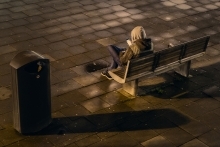National Survey on Unaccompanied Youth Homelessness in the U.S. Captures the Scope of the Issue
Body
On November 15, Chapin Hall at the University of Chicago released results from a new national survey on unaccompanied youth homelessness in the United States. The study, Missed Opportunities: Youth Homelessness in America, is the first of its kind to capture the scope of the issue broadly, by harnessing data from young people who have slept on the streets or in shelters; run away from or were kicked out of their homes; or couch surfed, living with friends and family. Findings show one in ten young adults ages 18-25, and at least one in 30 adolescents ages 13-17, experience some form of homelessness unaccompanied by a parent or guardian over the course of a year. This translates to 3.5 million young people ages 18-25 and 700,000 adolescent minors.
Voices of Youth Count is an unprecedented initiative to understand, address, and prevent youth homelessness. Chapin Hall, using its substantial research and policy assets, has conducted the most comprehensive research to date on youth homelessness, incorporating youth voices to develop achievable solutions. This research creates a foundation on which we can build solutions – effective policies and practices – to end homelessness for young people. Here are some of the findings:
Youth homelessness is a broad and hidden challenge.
- Over a 12-month period, 4.3% of households with 13- to 17-year-olds reported youth homelessness. This is 1 in 30 youth in America in that age group. This translates to a minimum of 700,000 adolescent minors or the equivalent of more than 800 average-sized high schools. About three-quarters of them involved explicit homelessness (including running away or being kicked out) and one-quarter involved couch surfing only.
Youth homelessness involves diverse experiences and circumstances.
- Nearly three-quarters of the young people who experienced “literal homelessness” (sleeping on the streets, in a car, or in a shelter) also said they had stayed with others while unstably housed.
- Young people struggle with a range of issues: 28% reported having substance use problems, and 66% reported mental health problems.
Prevention and early intervention are essential.
- Half of the youth who experienced homelessness in the past year did so for the first time. This means that it is not enough to respond to the problem; we must get in front of it.
- This finding was supported by the in-depth interviews that conducted in five sites. The majority of the youth interviewed had experiences of housing instability that started in childhood or adolescence.
Youth homelessness affects urban and rural youth at similar levels.
In predominantly rural counties, 9.2% of young adults reported any homelessness while, in predominantly urban counties, the prevalence rate was 9.6%.
- For 13- to 17-year-olds, household prevalence of any homelessness was 4.4% in predominantly rural counties, and 4.2% in mainly urban counties. •
- Homelessness is just as much of a challenge in rural communities as it is in more urban communities.
Access the full brief or one pager here: Missed Opportunities: Youth Homelessness in America.
